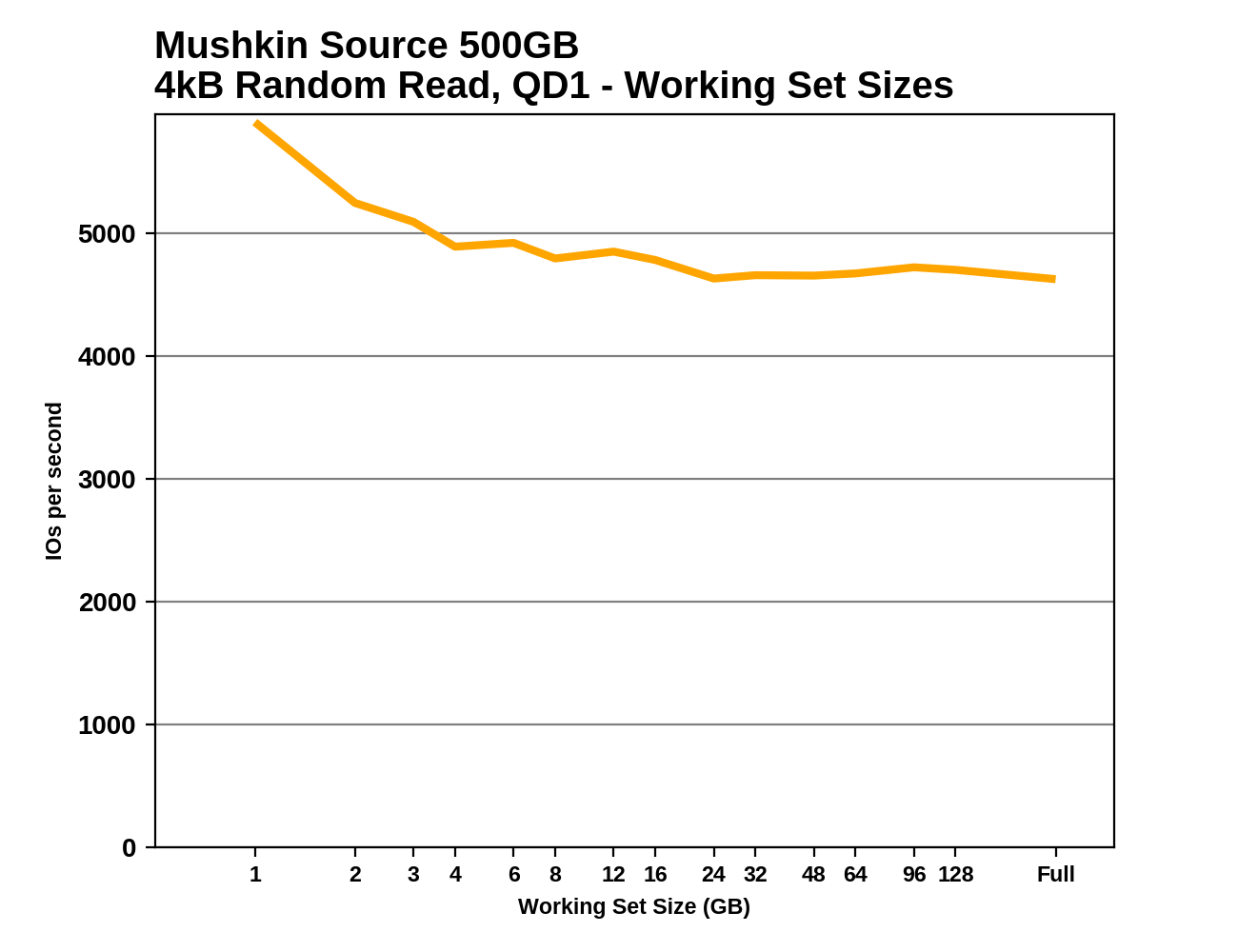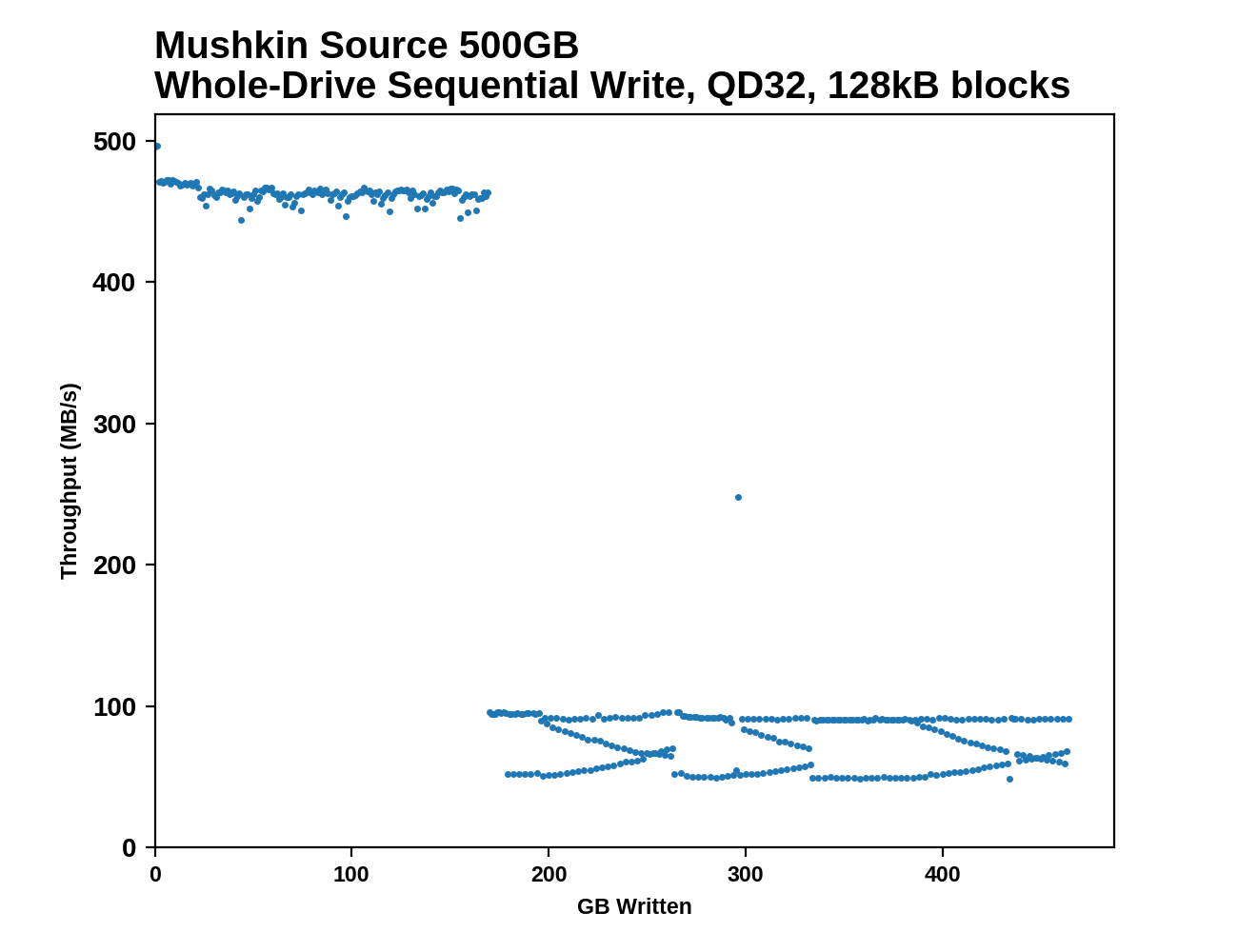The Mushkin Source 500GB SATA SSD Review: A Value Proposition For An Everyday PC
by Billy Tallis on November 21, 2018 10:00 AM ESTWorking Set Size
DRAMless SSDs may still have a bit of SRAM on the SSD controller to cache a portion of the flash translation layer's mapping tables. Just like a GB of external DRAM can hold the mapping tables for a TB of flash, a few MB of onboard RAM in the controller can hold the mappings for a few GB of flash. We can probe for such a cache by performing random reads with a varying working set size.
 |
|||||||||
The Mushkin Source shows some decline in random read performance as the working set size grows beyond just a few GB, but there's no sharp drop in performance like we see with DRAMless NVMe drives that are using the Host Memory Buffer feature. Most of the other drives show roughly the same random read performance regardless of working set size.
Whole-Drive Fill
This test starts with a freshly-erased drive and fills it with 128kB sequential writes at queue depth 32, recording the write speed for each 1GB segment. This test is not representative of any ordinary client/consumer usage pattern, but it does allow us to observe transitions in the drive's behavior as it fills up. This can allow us to estimate the size of any SLC write cache, and get a sense for how much performance remains on the rare occasions where real-world usage keeps writing data after filling the cache.
 |
|||||||||
The Mushkin Source lasts a very long time before its SLC cache is filled. While the Toshiba TR200's write speed ends up in the gutter very quickly, it will be almost impossible for a real-world consumer workload to fill the cache of the Source unless the drive starts out nearly full. From an empty drive, the apparent initial SLC cache size is well over 150GB—essentially the entire drive operating as SLC until free space runs out.
 |
|||||||||
| Average Throughput for last 16 GB | Overall Average Throughput | ||||||||
In the unlikely event that the SLC write cache on the Mushkin Source should overflow, its sequential write speed drops to the slowest in its class at just over 70 MB/s—slower than most mechanical hard drives. But this is only relevant when writing tens of GB at once.
BAPCo SYSmark 2018
BAPCo's SYSmark 2018 is an application-based benchmark that uses real-world applications to replay usage patterns of business users, with subscores for productivity, creativity and responsiveness. Scores represnt overall system performance and are calibrated against a reference system that is defined to score 1000 in each of the scenarios. A score of, say, 2000, would imply that the system under test is twice as fast as the reference system.
SYSmark scores are based on total application response time as seen by the user, including not only storage latency but time spent by the processor. This means there's a limit to how much a storage improvement could possibly increase scores, because the SSD is only in use for a small fraction of the total test duration. This is a significant difference from our ATSB tests where only the storage portion of the workload is replicated and disk idle times are cut short to a maximum of 25ms.
| AnandTech SYSmark SSD Testbed | |
| CPU | Intel Core i5-7400 |
| Motherboard | ASUS PRIME Z270-A |
| Chipset | Intel Z270 |
| Memory | 2x 8GB Corsair Vengeance DDR4-2400 CL17 |
| Case | In Win C583 |
| Power Supply | Cooler Master G550M |
| OS | Windows 10 64-bit, version 1803 |
Our SSD testing with SYSmark uses a different test system than the rest of our SSD tests. This machine is set up to measure total system power consumption rather than just the drive's power.



For the Creativity and Productivity subtests, the Mushkin Source and other DRAMless SSDs offer performance indistinguishable from a mainstream SATA SSD with a DRAM cache; these scenarios are more bottlenecked by CPU power and system RAM. The responsiveness test does reveal some of the reduced performance of DRAMless SSDs, but even so they greatly outperform a mechanical hard drive.
Energy Use
The SYSmark energy use scores measure total system power consumption, excluding the display. Our SYSmark test system idles at around 26 W and peaks at over 60 W measured at the wall during the benchmark run. SATA SSDs seldom exceed 5 W and idle at a fraction of a watt, and the SSDs spend most of the test idle. This means the energy usage scores will inevitably be very close. A typical notebook system will tend to be better optimized for power efficiency than this desktop system, so the SSD would account for a much larger portion of the total and the score difference between SSDs would be more noticeable.

The DRAMless SSDs use a bit less energy during a SYSmark run than the mainstream Crucial MX500, but the HP S700 is the only one that really stands out as saving a non-trivial amount of power, and even in that case the difference is small enough to only matter for low-power notebooks, not our desktop testbed.










30 Comments
View All Comments
Amandtec - Wednesday, November 21, 2018 - link
On PC Partpicker you can chose a chinese brand 500GB for about $42 vs about $72 for the Samnsung. So it is a little more than 10% difference.piroroadkill - Wednesday, November 28, 2018 - link
So $30 to not lose your data? Sounds like a good deal.piroroadkill - Wednesday, November 28, 2018 - link
Yeah, the SSD market is filled with wrong decisions.I just basically go for a TLC Samsung drive that fits the budget, and pretty much ignore everything else.
kmmatney - Wednesday, November 21, 2018 - link
Microcenter has their Inland 480GB SSD for $59.99. I have bought about 10 of the Inland SSDs so far, in various sizes (mostly the 240GB for $33). They have all worked great for normal everyday workloads, and most of these were installed as boot drives. The Microcenter SSDs are also DRAMless - maybe they don't bench as well, but they still have that SSD feel to them, and perform well doing normal tasks.fmcjw - Wednesday, November 21, 2018 - link
Well written article, thorough but not verbose, thank you Billy! Reminds me of Anand and Bruce...Recently bought a 480GB no name SSD that uses the same controller and NAND for only around $40 (singles day deal here in my home market in Taiwan). It has similar characteristics to the Source as you described (full disk SLC cache, etc.), but returned it because it makes a loud/hi-freq electrical noise when written to and read from. Forums here say that the 2258XT (or its ASMedia licensed copy) can overheat under heavy use and die before the NAND expires, so thermal design and general electrical design/component quality is critical. I'm not sure if you examined these design flaws or if you plan to add them to future routines? Granted it's probably specific to each production batch, but might be worth checking on each drive that you come across if it's not too much work.
I understand you include links to Destroyer methodology, but it will be helpful to briefly describe what constitutes a "full" and "empty" drive in brief, for faster reading without having to click through.
Also, a bit curious about SLC caching, its different types and what that means for real world usage. I imagine frequently accessed operating system files should be kept in SLC, and not moved into TLC, but unsure if any firmware is so smart about this. If if keeps moving files without discretion it will also be bad for write amplification.
Thanks again!
Billy Tallis - Thursday, November 22, 2018 - link
I hadn't heard about 2258XT controllers dying or overheating. It hasn't happened to any of my drive samples yet. I also don't recall hearing coil whine coming off the Source, though I have heard it from a few SSDs during testing.For the full-drive ATSB Heavy and Light test runs, the drive is filled with sequential writes of random data to every single sector, then given a five minute break to cool off and flush caches before the test begins.
TLC drives generally treat the SLC cache as a write buffer, and will aggressively migrate data from SLC to TLC blocks during idle times. The QLC drives on the market so far are much more willing to keep data in SLC until it is necessary to compact it into QLC blocks, so the SLC cache helps with write and read performance. I'm not aware of any drives that move frequently-read data from TLC/QLC blocks back to SLC to optimize read performance.
gglaw - Saturday, November 24, 2018 - link
Billy - I don't get the indications of when the performance falls off after the SLC cache is full. The graphs indicate it drops off after around 170GB of data is written. How is this possible on a budget TLC drive? Does this mean there is 170GB of SLC cache on this drive? That couldn't be true for a budget DRAM-Less drive since it would add way much to the cost of the drive that the market it is targetting would not need. No one buying this type of drive would be doing workloads to push it past this threshold so it makes 0 business sense to equip it in this way. Basically no performance sense either since this large of a cache will never be used by customers buying bottom barrel drives.I'm probably reading it entirely wrong - do you have a clearer explanation of what is going on?
Billy Tallis - Saturday, November 24, 2018 - link
The full-drive sequential write test is essentially a best-case scenario that illustrates the maximum possible SLC cache size for drives with variable-size caches. The drive starts out empty so the SLC cache is at its largest size, and sequential writes are easier for the controller to handle than random writes.It looks like the Mushkin Source more or less runs all of its NAND as SLC initially, which is why it takes so long for the write speed to drop. It's also possible that the write throughput from the controller to the NAND is significantly faster than the SATA link, so the drive might have some slack to start folding data from SLC to TLC blocks in the background before the cache fills up.
The other SM2258 drives appear to start folding before the cache is full, but with the slower 32L TLC that did have an impact on the write speed.
At some point I may expand the SLC cache test to better show the range of behaviors for variable-size caches.
WasHopingForAnHonestReview - Thursday, November 22, 2018 - link
Great review, thank you.excelle08 - Thursday, November 22, 2018 - link
This could benefit for non-power user consumers who just want faster booting or everyday software loading. However the price is not reasonable for such a piece of junk - Intel's 660p already sucks, let alone this unknown brand who is likely to use "who knows" black/white flash chips, plus without DRAM cache. If I only have $30 budget for storage I'd rather go to ebay and search for a used older SATA2 MLC stuff(such as Intel X-25M) than this 120G QLC drive.